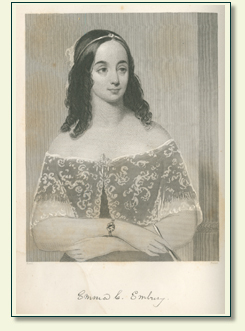|
|
|
|
|
|
|
New Yorker Emma Embury frequently contributed children's stories, poems, essays, and articles to several of the leading periodicals of her time, some of which listed her among their editorial staff. Much of this work appeared anonymously and went financially uncompensated, for she never aspired to a literary "career" or even claimed authorship as a profession. Together with her husband, Daniel Embury, a president of Atlantic Bank, she hosted a salon in their home and gained renown as a charming hostess to the city's upper crust. Interested in educational opportunities for women, she lectured on "Female Education" at Brooklyn Collegiate Institute for Young Ladies, an address which Ann Brackett included in Woman and Higher Education (1893). Illness ended her activities as a writer and hostess in 1848, and though she lived another fifteen years, she spent several of them completely bedridden. Two collections of her work, The Poems of Emma C. Embury and Selected Prose Writings of Mrs. Emma C. Embury were published posthumously. In 1846, Edgar Allan Poe described her in his “The Literati of New York City. No. IV,” in Godey’s Lady’s Book, v. 33, p. 77: She
is about the medium height; complexion, eyes, and hair light; arched
eyebrows; Grecian nose; the mouth a fine one and indicative of firmness; the
whole countenance pleasing, intellectual and expressive. The portrait in “Graham’s
Magazine” for January, 1843, has no resemblance to her whatever. Other portraits appear in:
|
|
|
|


